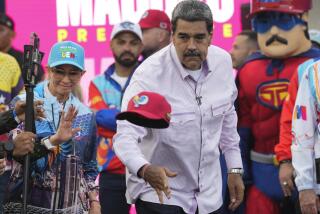Fake dollars from Peru trouble U.S.
- Share via
WASHINGTON — A flood of high-quality counterfeit U.S. money from Peru is perplexing federal authorities, who say the shadowy networks that are responsible are also engaging in other criminal activity that poses a threat to national security.
Over the last year, authorities and banks have recovered at least $7.8 million in fake notes across the United States that they believe were manufactured in Peru, according to Secret Service statistics. In addition, $446,280 in fake U.S. cash from Peru was seized before it was spent during that same period, and more than $18.2 million more in raids in the South American country, the Secret Service said.
“And that’s just a fraction of the notes that we can ally to Peru” worldwide, said John Large, the assistant special agent in charge of the Secret Service’s criminal division at its headquarters in Washington. “It’s a form of economic terrorism.”
Besides costing U.S. citizens and businesses millions in losses, Large said, the international counterfeiting rings undermine confidence in U.S. currency. That is especially the case in countries in South America and elsewhere that have “dollarized” economies, in which U.S. bills are accepted as an official form of currency.
The Secret Service launched a special task force in February in partnership with the Peruvian National Police and stepped up training for Peruvian officials and bankers in how to go after counterfeiters. The State Department issued a warning to travelers last month, saying that “counterfeit U.S. currency is a growing and serious problem in Peru.”
A similar crackdown in Colombia in recent years helped authorities sharply reduce the rampant counterfeiting of U.S. currency. Colombia used to account for as much as 70% of the counterfeit currency passed annually in the United States, but law enforcement initiatives have dropped that level to about 5% domestically, Secret Service statistics show. Counterfeiters in Colombia still print millions in fake U.S. dollars.
The successes in that country, however, resulted in at least some of the Colombian counterfeiters moving to Peru, which does not have as robust an anti-fraud force or system of anti-counterfeiting laws.
The Secret Service first noticed a trickle of fake bills coming out of Peru in 2003. Two years ago, agents began reporting a steady stream of fake currency in Miami, some smuggled in by human “mules” who hid it on their bodies or in packages and even in greeting cards.
One woman was observed passing seven counterfeit $100 notes at the Macy’s Galleria Mall in Fort Lauderdale, Fla., according to Secret Service officials. They said further investigation revealed that she had been traveling every month to the Peruvian capital, Lima, and she was arrested at Miami International Airport with $47,300 in counterfeit $100 bills in her luggage and on her body.
Kris Buckner, a former Los Angeles County sheriff’s deputy, said groups spreading counterfeit money from Peru have been active in Southern California for some time. But, he said, it is hard to get good intelligence on them. “The guys who are selling the counterfeit money are also selling guns and drugs and counterfeit goods. It’s a never-ending cycle of criminal activity,” said Buckner, who now heads Investigative Consultants, a Los Angeles-area group that tracks counterfeiting and piracy.
Large and other U.S. and Peruvian officials say some of the Peruvian counterfeiters are also engaged in drug trafficking and making fake passports, visas and other documents. They fear that terrorists could use the documents, and even the fake cash, to make their way into the United States.
In one recent raid in Peru, authorities seized forged passports from 16 countries.
Large and other authorities say they have made 24 arrests and taken down 17 counterfeiting plants in Peru in the raids, which have netted $18.2 million in fake U.S. currency since February.
In one raid in April, U.S. and Peruvian officers seized $8.4 million in counterfeit $100 bills, eight lithographic printing presses and numerous plates and negatives used in the manufacture of counterfeit currency. They also arrested five suspects.
--
More to Read
Sign up for Essential California
The most important California stories and recommendations in your inbox every morning.
You may occasionally receive promotional content from the Los Angeles Times.










